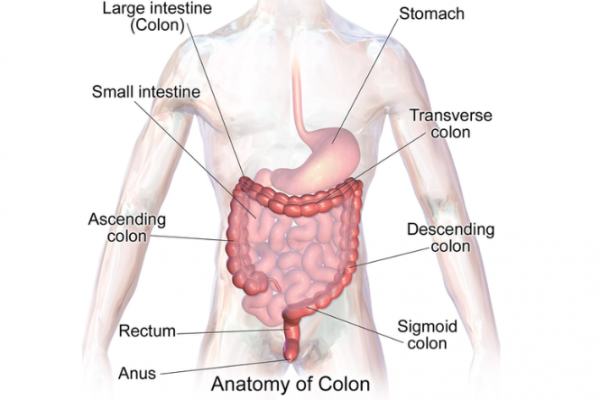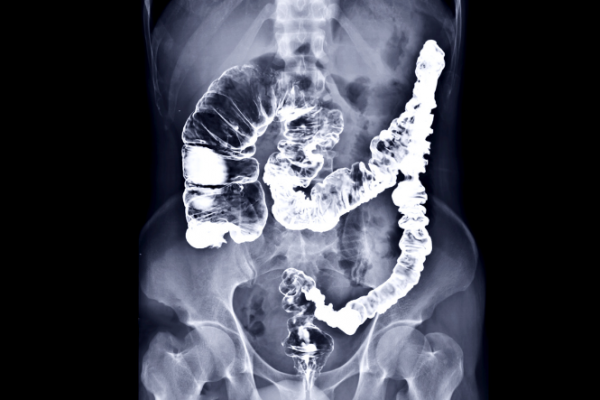Barium enema
Key points about barium enema
- A barium enema is a test that highlights the lower part of your bowel so it can be seen in an X-ray.
- A heavy white liquid called barium is put into your bowel through your bottom.
- Barium coats the inside of your bowel making it easier to see any problems on the X-ray.
- The barium is then passed out with your poo, your body doesn't absorb it.

A barium enema is a test used to check your large bowel (colon and rectum). Barium is a chalky white liquid which is put into your bowel though a tube in your bottom (rectum). This shows a clear outline of the inside of your bowel on X-rays.
The lower part of your colon has 4 parts – the ascending colon, the transverse colon, the descending colon and the sigmoid colon which joins to your rectum. 
Image credit: Blausen.com wikimedia commons
These lower parts of your bowel aren't easy to see on an X-ray. Barium coats the inside lining of your bowel to make it easier to see changes such as tumours, polyps, blockages, pouches and narrowed parts. Barium isn't radioactive and isn't absorbed by your body. It's passed out with your poo. The image below shows the highlighted area on an X-ray.
Image credit: Canva
Barium enemas are usually done in radiology centres by a radiologist (a specialist doctor who interprets X-rays) or a radiographer (a healthcare provider who operates X-ray and imaging machines). There will usually be a nurse there too.
A barium enema can be unpleasant and uncomfortable but it shouldn’t be painful.
A barium enema is done to look at your colon to make or confirm a diagnosis. It may be done:
- if you have blood in your stools (poo)
- if your bowel habits have changed
- to find growths or polyps
- to diagnose bowel cancer
- for inflammatory conditions of the bowel such as ulcerative colitis or Crohn's disease.
Barium enema used to be quite a common test, but colonoscopy or CT scans are usually used now. There are still some specific reasons to choose a barium enema instead, your healthcare provider will discuss this with you. Barium enemas aren't done during pregnancy because the X-rays may harm the baby so let your healthcare team know if you're pregnant or think you could be pregnant. They are also not advised in some situations, eg, for people with a suspected bowel perforation, severe ulcerative colitis or severe abdominal pain.
You should receive instructions from the radiology service before your appointment. Your bowel needs to be completely clean so it can be seen clearly. You will usually be asked to:
- Eat a light diet for a few days leading up to the test – low fibre foods such as clear soup, white bread, white rice, pasta, peeled potato, cheese, plain crackers. Talk to your healthcare provider if you have diabetes as you may need to follow different dietary instructions in order to manage your glucose levels.
- Take laxative medicine to help empty your bowels. The radiology centre will let you know which medicine to take and how to take it.
- Drink plenty of clear fluids in the 24 hours before the test.
You can bring a support person with you on the day but they won't be able to come in with you while you have your procedure as it involves X-rays.
Before the test
You will be asked to change into a hospital gown and take off all jewellery. There will be private spaces for you to get changed in.
During the test
The barium test usually takes about 45 minutes. You will be asked to lie on a special X-ray table and you may be given a medicine to help relax your bowel muscles.
The radiologist will put a small, soft tube a few centimetres into your bottom and it will stay there all through your test. The radiologist will pass barium through the tube. You may feel you need to poo, but try to tighten your bottom muscles around the tube. Taking slow, small breaths will also help. You may have some air pumped into your bottom to help spread the barium and expand your bowel. You'll be asked to roll over so the barium coats all the way around your bowel.
The radiology team will take several X-rays from different angles. As each X-ray is taken, you'll be asked to lie still and hold your breath. Once they're done, the tube will be taken out and the procedure is complete. You can then go to the toilet to empty your bowels.
After the test
It's best to arrange for somebody to drive you home in case you feel unwell after the test. You may need to stay close to a toilet for a while afterwards, so you can get rid of any barium and air still inside you.
In the next few days:
- You can eat and drink as normal – drink plenty of fluids and eat high-fibre foods to help stop the barium causing constipation.
- You may have some bloating, wind or stomach cramps.
- Your poo may be whitish in colour for the next few days. This is normal and it’s due to the colour of the barium.
- If you have an inflammatory bowel condition such as ulcerative colitis, barium enema can aggravate this.
- The results of the test will be sent to the healthcare provider who referred you, and they'll arrange a time with you to talk through your results.
A barium enema is considered to be a safe test, but there are a few points to be aware of:
- A very small number of people can be allergic to barium. If you are allergic to other medicines, contrast media, iodine or latex you should let your healthcare provider know.
- All X-ray examinations involve exposure to a very small dose of radiation. This is thought to be safe.
- Barium enemas have been known to aggravate ulcerative colitis.
- There is a very small risk of putting a hole in the side of your bowel.
Barium enema(external link) Health New Zealand | Te Whatu Ora Auckland
Barium enema – a patient's guide(external link) Family Doctor, NZ
References
- Barium enema(external link) NHS, UK, 2022
- Barium sulphate(external link) New Zealand Formulary, NZ
- Barium enema examination(external link) Patient Info, UK, 2023
- Barium enema(external link) Johns Hopkins, US
Credits: Healthify editorial team. Healthify is brought to you by Health Navigator Charitable Trust.
Reviewed by: Dr Emma Dunning, Clinical Editor and Advisor
Last reviewed:





